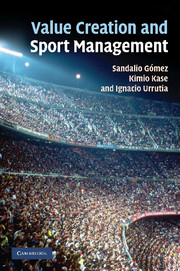Book contents
- Frontmatter
- Dedication
- Contents
- List of figures
- List of tables
- List of contributing authors
- Foreword
- Introduction
- 1 The virtuous circle of value creation in the sports industry
- 2 Value creation and performance criteria for sport entities
- 3 National context and profit strategy of the sport entity
- 4 Value creation in two of the most prestigious Spanish football clubs
- 5 The proto-image of Real Madrid
- 6 Value creation from the organizational structure of a sports entity
- Appendix I Why NGOs matter for the success of sporting events
- Appendix II Strategic evaluation of sponsorship and patronage
- Appendix III Structural characteristics of sport organizations
- Index
- References
3 - National context and profit strategy of the sport entity
how to overcome the national borders of the sport entities?
Published online by Cambridge University Press: 05 February 2014
- Frontmatter
- Dedication
- Contents
- List of figures
- List of tables
- List of contributing authors
- Foreword
- Introduction
- 1 The virtuous circle of value creation in the sports industry
- 2 Value creation and performance criteria for sport entities
- 3 National context and profit strategy of the sport entity
- 4 Value creation in two of the most prestigious Spanish football clubs
- 5 The proto-image of Real Madrid
- 6 Value creation from the organizational structure of a sports entity
- Appendix I Why NGOs matter for the success of sporting events
- Appendix II Strategic evaluation of sponsorship and patronage
- Appendix III Structural characteristics of sport organizations
- Index
- References
Summary
Introduction
Can sport entities move away from their national context? If so, how? If not, why not? In the first step, based on football, this chapter answers those questions and contends that sport clubs are conditioned by their national context. This contention is later tested by extrapolating the argument to other sports and to a non-European context. In the light of the prevalence of the national context in the management of sport entities, another question is raised about whether to push forward the internationalization or regionalization in future. The similarities between sports and other industries, such as the automotive and entertainment industries, are discussed.
In the absence of one best way for sport entities to expand and, its corollary, the existence of different ways to create value thanks to the sport, financial and stakeholder dimensions, always provide more opportunities to perform successfully on a national and international basis. Moreover, expansion opportunities are increased through the possibility of generating a virtuous circle among the fans, the city, the media, the sponsor and the sport team or sport event, in relation to the different forms of sport capitals, whether historic, social, economic or media.
- Type
- Chapter
- Information
- Value Creation and Sport Management , pp. 60 - 102Publisher: Cambridge University PressPrint publication year: 2010



